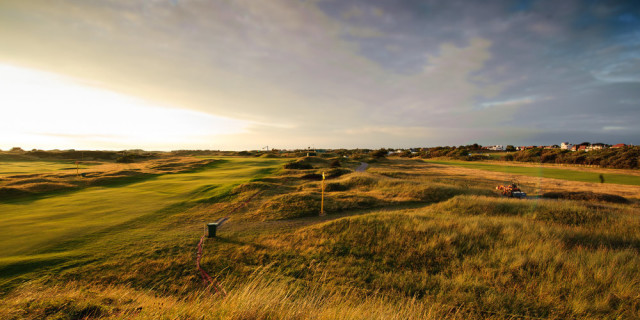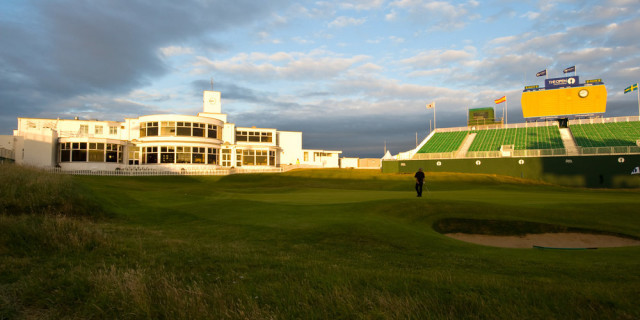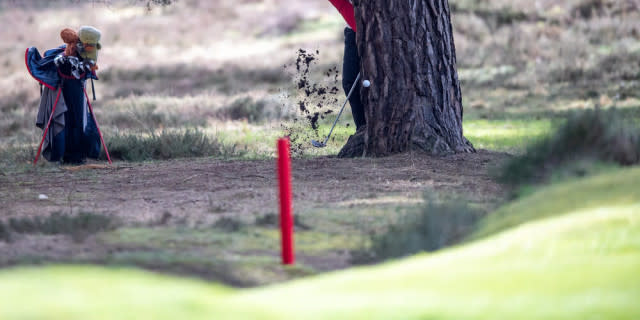
Explore all 18 Holes at Royal Birkdale
The Open is being played at Royal Birkdale, near Southport. It is a par 70, measuring 7,156 yards and last staged the tournament in 2008, when Padraig Harrington won. The lowest score that year was the 65 recorded by Camilo Villegas.
Situated in the northwest coast of England, Birkdale is a magnificent links with fairways weaving between huge sand dunes which offer fantastic vantage points for the tens of thousands of spectators who will be watching The Open.
The course features plenty of tight fairways, demanding accuracy from the tee at all costs, and it is all overlooked by a glorious white art deco clubhouse that sits behind the final green.
It has seen many memorable moments, including Arnold Palmer’s amazing recovery shot from a bush on the 16th hole in 1961- a plaque now marks the spot. It was also where Peter Thomson won the last of his five Opens.

First, par four, 448 yards
The first at Royal Birkdale is one of the toughest opening holes on the Open rota. The fairway sweeps left past a bunker cut into the left-hand side of the landing area and then right to a green partially hidden by a mound to the right and protected by bunkers on both sides. There is out-of-bounds down the right-hand side of the hole. Most players will happily settle for a par.
Second, par four, 422 yards
Usually played into the wind and calls for a straight drive between two bunkers on the right and a fearsome mound on the left. The green is also protected by sand at the front and slopes slightly from back to front which means that any approach struck past the hole will leave a deceptively fast putt back down the hill.
Third, par four, 451 yards
The third is played in the opposite direction to the second hole. It was extended by more than 40 yards before The Open in a 2008, along with a bunker that was added to protect the right side of the green. The ideal drive is to the left, but the fairway is undulating and players often get bad bounces. It usually plays with a crosswind adding to the difficulty.
Fourth, par 3, 199 yards
The first par three is played from an elevated tee to a green 30 feet below that falls away on both sides and is protected by bunkers at the front, left and right. It us usually played with a left-to-right crosswind.
Fifth, par 4, 346 yards
This is a classic risk and reward hole featuring a marked dog-leg to the right, and is a good birdie opportunity. The longer hitters will cut the dogleg and get very close to the green, which slopes from back to front and is surrounded by seven bunkers.
Sixth, par 4, 499 yards
Another dog leg, from left to right, and the hardest hole on the course. The drive must be struck between bunkers on either side of the landing area followed by an approach to a slightly elevated green guarded by three bunkers. A bank on the left of the fairway is to be avoided at all costs.
Seventh, par 3, 177 yards
The second par three is once again played from an elevated tee to a small putting surface that resembles an upturned saucer. It is surrounded by bunkers and will only hold shots that are perfectly struck. Expect to see a lot of players in the sand.
Eighth, par 4, 458 yards
Two new fairway bunkers were installed for the 2008 Open at 270 yards on the left of the fairway and 307 yards on the right. The large green slopes from back to front. Normally plays downwind and offers another birdie chance.
Ninth, par 4, 416 yards
The tee shot at the ninth is a blind one to a narrow fairway. The hole is a left-to-right dogleg with no fairway bunkers but two deep traps protect the front left and right of the green. Crosswinds and a firm fairway add to the challenge and a mound to the right must be avoided.
10th, par 4, 402 yards
The drive must carry at least 270 yards to get beyond three bunkers on the left and right of the fairway. These bunkers are penal and anybody who finds them can expect to drop a shot. The hole is a sharp dogleg played to a green set into the side of another sand dune.
11th, par 4, 436 yards
The eleventh is usually played into the wind, with four well placed bunkers waiting to catch any drive hit slightly off line. These lie at 278, 309, 321 and 340 yards from the tee. A ditch to the right will also catch some tee shots. The green is protected by a trap to the left. There is a new tee for 2017.
12th, par 3, 183 yards
The 12th is one of the best short holes on The Open rota. The green, which is built into the side of a dune, is protected by deep bunkers and thick grass left and right. The green is narrow on a hole usually played with a right to left crosswind.
13th, par 4, 499 yards
Once again, accuracy is the key at the 13th, which features eight fairway bunkers. Avoid all of those and you face a second shot to a large green that sits beside another sand dune and is guarded by three further sand traps.
14th, par 3, 200 yards
The final par three is perhaps the most difficult of the lot, and not because it is the longest. The tee is protected by a dune, which means that players struggle to judge both the strength and direction of the wind. Just to add to the difficulty, there are five bunkers and a series of grassy swales which protect the left, right and rear of the putting surface.
15th, par 5, 542 yards
The 15th is the first of only two par fives, and it is a cracker. A mind-boggling 13 bunkers line the fairways and will catch anything other than a drive struck straight down the middle. There are two further bunkers at the green. In 2008 there were 92 birdies, but there were also 85 bogeys, 20 double-bogeys and three "others". The second shot will be hit over thick gorse if the wind is blowing from right to left to a two-tiered green.
16th, par 4, 438 yards
A big carry over rough is required to reach a narrow fairway that features two bunkers on the right. The second shot is to an elevated green surrounded by five well-placed bunkers. It was on this hole in 1961 that Arnold Palmer smashed the ball from a bush to the green on his way to his first victory at The Open. A plaque marks the spot from where Palmer played that shot.
17th, par 5, 567 yards
The Open could be won or lost on the 17th, which demands a drive that must carry two large sand dunes situated to the left and right of the fairway and avoid two bunkers hidden down the right-hand side of the fairway 312 and 323 yards from the tee. Three bunkers protect a long, narrow and heavily contoured green. The green is surrounded by banks and swales. Padraig Harrington secured The Open in 2008 when he struck his second shot to five feet and holed the putt for an eagle.

18th, par 4, 473 yards
A magnificent finishing hole. If somebody comes to the 18th knowing that he needs a four to win then he will have his work cut out for him. There is a bunker and out of bounds on the right, and if the adrenalin is flowing then a bunker at 304 yards on the left will come into play. Another trap lies in wait at 349 yards, and the approach is played to a green protected by three further bunkers.
Images Courtesy of Kevin Diss Photography.

The oldest & most prestigious major, a trip to The Open is a must for every golf fan. From tickets and transfers to hospitality & golf, Golfbreaks.com can build the perfect package to help you experience The Open in style.
What do you think? post your thoughts and feedback on the Golfshake Forum: https://forum.golfshake.com/
Tags: The Open









